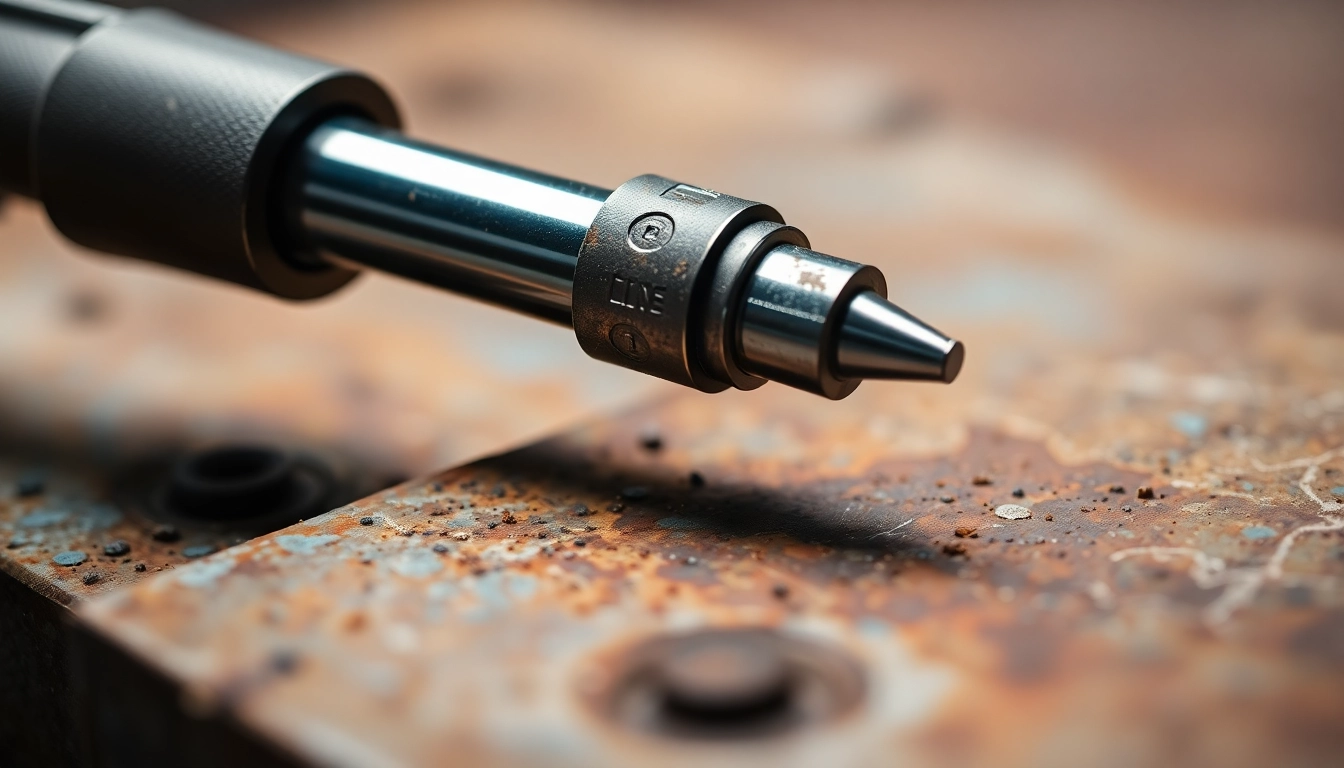Understanding the Needle Gun
What is a Needle Gun?
A needle gun, commonly referred to as a needle scaler, is a powerful pneumatic tool used primarily in metalworking to remove unwanted materials. These materials can include rust, paint, dirt, and welding slag from various metal surfaces. The needle gun operates using a series of rapidly reciprocating needles that penetrate the surface of the material, providing a thorough cleaning or preparation without causing damage to the underlying substrate. This tool is an essential asset in industries where metal integrity and surface cleanliness are critical, such as shipbuilding, automotive, and construction.
History and Evolution of Needle Guns
The concept of the needle gun originated from historical firearms known as needle guns, which utilized a needle-like firing mechanism. However, the term needle gun in contemporary contexts has largely evolved to refer to the cleaning tool rather than firearms. The development of the modern needle gun can be traced back to the industrial revolution when the need for efficient surface preparation methods became paramount to manufacturing processes.
Over the years, needle guns have gained significant popularity due to their effectiveness in preparing surfaces for welding and painting. Innovations in pneumatic technology have resulted in lighter, more efficient designs, greatly enhancing performance and user-friendliness. Today, these tools are available in various types, including electric and pneumatic models, catering to a broad range of applications across different industries.
Different Types of Needle Guns and Their Uses
Needle guns can be categorized into several types, each tailored for specific applications and materials:
- Pneumatic Needle Guns: The most common type, powered by an air compressor, which provides a high rate of speed and efficiency in surface preparation. Ideal for heavy-duty applications.
- Electric Needle Guns: These provide a convenient alternative for areas where compressed air isn’t readily available. They are typically quieter and can be used in indoor settings.
- Compact Needle Guns: Small, portable versions designed for lighter tasks, such as removing paint from surfaces in tight spaces.
- Heavy-Duty Needle Guns: Equipped with more robust construction and higher power output, suitable for industrial applications where significant material removal is necessary.
Each type has its specific benefits and applications, and selecting the right one depends on the project requirements, including the type of surface being treated, the level of contamination, and accessibility considerations.
Benefits of Using a Needle Gun
Efficiency in Surface Preparation
One of the primary advantages of using a needle gun is its efficiency in surface preparation. The tool’s rapid firing rate allows it to quickly remove layers of paint, rust, or other contaminants, significantly reducing the amount of time required for surface cleaning compared to manual methods like scrapers or wire brushes. For instance, a pneumatic needle gun can operate at speeds of up to 4000 blows per minute, making it a favorite choice for professional metalworkers who need to maximize productivity.
Versatility in Application
Needle guns are versatile tools, effective on various materials, including steel, aluminum, and even composite surfaces. This versatility makes them suitable for a wide array of applications, from shipyard maintenance to automotive repairs and building renovations. They can handle intricate surface profiles, accessing hard-to-reach areas that other tools may not, making them indispensable in many industrial settings.
Cost-Effectiveness for Businesses
Investing in a needle gun can be a cost-effective decision for businesses. The speed at which these tools operate can drastically reduce labor costs by minimizing the time workers spend on surface preparation. Moreover, the durability of needle guns means they can withstand rigorous use over time, ultimately providing long-term savings on maintenance and replacement costs. Businesses that prioritize efficiency and cost-effectiveness are increasingly adopting needle guns as a standard tool in their equipment arsenal.
How to Choose the Right Needle Gun
Assessing Your Project Needs
Choosing the right needle gun starts with a thorough assessment of your project needs. Consider the specific materials you will be working with, the types of contaminants present, and the scale of the tasks at hand. For light-duty projects, such as residential paint removal, a compact or electric needle gun may suffice. However, for heavy industrial applications involving extensive rust removal or surface preparation before welding, a high-capacity pneumatic needle gun would be more appropriate.
Understanding Specifications: CFM and PSI
Another crucial factor in selecting a needle gun is understanding the specifications related to air pressure and volume. The performance of pneumatic needle guns is often rated by CFM (cubic feet per minute) and PSI (pounds per square inch). Most needle guns require a minimum CFM range of 8-16 at 90 PSI to function effectively. Evaluating your air compressor’s capabilities to ensure it matches or exceeds these requirements is essential to avoid operational issues.
Top Brands and Models of Needle Guns
When it comes to purchasing needle guns, several reputable brands stand out in the market. Brands like Ingersoll Rand, Chicago Pneumatic, and JET offer a variety of models renowned for their durability, efficiency, and innovative features. Researching product reviews and user experiences can provide valuable insights into which model best fits your specific needs. It’s recommended to consider warranty options and customer service reputation when selecting a brand, as these can significantly impact the long-term satisfaction with your investment.
Operational Guidelines for Needle Guns
Preparation and Safety Measures
Before operating a needle gun, follow essential safety measures to ensure a safe working environment. Always wear appropriate personal protective equipment (PPE), including safety goggles, gloves, and ear protection, to minimize the risks of inhalation of loose debris and noise exposure. Proper training on the tool’s operation and understanding of its controls is imperative to prevent accidents and injuries.
Additionally, ensure the workspace is clean and free from flammable materials, as the operation can generate sparks and debris. Proper ventilation is also critical, particularly when working indoors, to facilitate the dispersion of dust and particles generated during use.
Step-by-Step Operating Instructions
To effectively use a needle gun, follow these step-by-step instructions:
- Setup: Connect the needle gun to the appropriate air compressor, ensuring the CFM and PSI requirements meet the tool specifications.
- Test Run: Before starting on the project, perform a test run to check for any malfunctions and to familiarize yourself with the tool’s operational behavior.
- Surface Preparation: Position the needle gun at a slight angle to the surface you are working on. Start at one edge and move the gun in a steady motion across the surface to ensure even coverage.
- Monitoring: Continuously monitor the surface during operation to avoid over-working certain areas, which can cause damage.
- Completion: After finishing the task, detach the needle gun from the compressor and clean the tool to remove any debris. Store it properly to ensure its longevity.
Maintenance Tips for Longevity
To ensure the longevity of your needle gun, regular maintenance is essential:
- Periodic Cleaning: Clean the tool after each use to remove dust and debris, which can accumulate and affect performance.
- Lubrication: Apply a few drops of oil to the air line regularly to keep internal parts lubricated and functioning smoothly.
- Inspection: Routinely inspect for wear and tear, particularly focusing on the needles. Replace any worn-out or damaged parts promptly to maintain efficiency.
Common Issues and Troubleshooting
Identifying Performance Problems
Even the best needle guns can encounter performance issues over time. Common problems include inadequate power, slow operation, or erratic needle movement. Identifying these issues early can save time and money. Listen for unusual sounds or irregular vibrations, which can indicate a malfunction.
Solutions for Common Needle Gun Issues
Here are some solutions to common issues:
- Low Power Output: Check the air compressor settings and ensure that it meets the required CFM and PSI for your needle gun.
- Needles Not Moving: Ensure that the needles are properly installed and not blocked by debris. Replace any damaged needles immediately.
- Excessive Vibration: This could be due to misalignment or wear; inspect for damage and replace components as needed.
When to Seek Professional Help
If you encounter persistent issues that cannot be resolved through troubleshooting, it may be time to consult a professional. Technicians can provide deeper diagnostics and repairs that may involve specialized knowledge or equipment. Regular inspections by professionals can also prevent future issues and prolong the tool’s lifespan.



